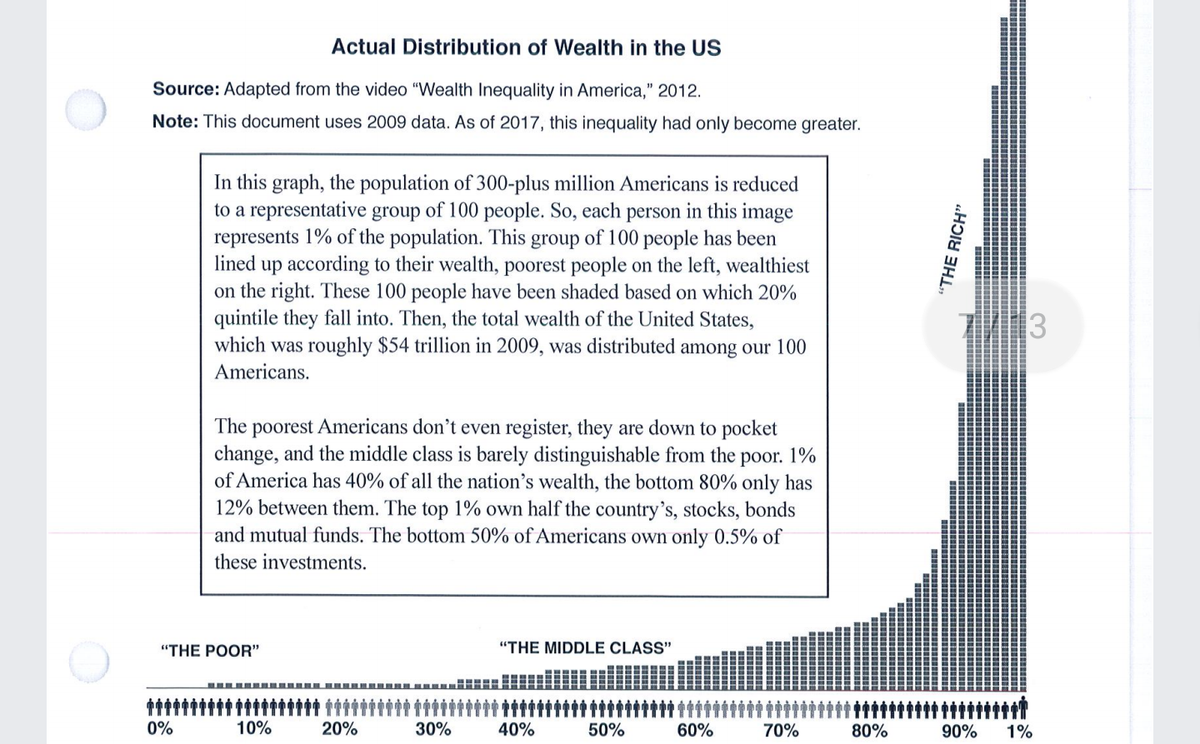Micro Economics For Today
10th Edition
ISBN:9781337613064
Author:Tucker, Irvin B.
Publisher:Tucker, Irvin B.
Chapter12: Income Distribution, Poverty, And Discrimination
Section: Chapter Questions
Problem 17SQ
Related questions
Question

Transcribed Image Text:5. How can you use this document to argue that the US should reduce economic inequality?

Transcribed Image Text:Actual Distribution of Wealth in the US
Source: Adapted from the video "Wealth Inequality in America," 2012.
Note: This document uses 2009 data. As of 2017, this inequality had only become greater.
In this graph, the population of 300-plus million Americans is reduced
to a representative group of 100 people. So, each person in this image
represents 1% of the population. This group of 100 people has been
lined up according to their wealth, poorest people on the left, wealthiest
on the right. These 100 people have been shaded based on which 20%
quintile they fall into. Then, the total wealth of the United States,
which was roughly $54 trillion in 2009, was distributed among our 100
Americans.
The poorest Americans don't even register, they are down to pocket
change, and the middle class is barely distinguishable from the poor. 1%
of America has 40% of all the nation's wealth, the bottom 80% only has
12% between them. The top 1% own half the country's, stocks, bonds
and mutual funds. The bottom 50% of Americans own only 0.5% of
these investments.
"THE POOR"
"THE MIDDLE CLASS"
0%
10%
20%
30%
40%
50%
60%
70%
80%
90%
1%
"THE RICH"
Expert Solution
This question has been solved!
Explore an expertly crafted, step-by-step solution for a thorough understanding of key concepts.
This is a popular solution!
Trending now
This is a popular solution!
Step by step
Solved in 2 steps

Knowledge Booster
Learn more about
Need a deep-dive on the concept behind this application? Look no further. Learn more about this topic, economics and related others by exploring similar questions and additional content below.Recommended textbooks for you



Principles of Microeconomics
Economics
ISBN:
9781305156050
Author:
N. Gregory Mankiw
Publisher:
Cengage Learning



Principles of Microeconomics
Economics
ISBN:
9781305156050
Author:
N. Gregory Mankiw
Publisher:
Cengage Learning

Principles of Economics 2e
Economics
ISBN:
9781947172364
Author:
Steven A. Greenlaw; David Shapiro
Publisher:
OpenStax

Microeconomics: Private and Public Choice (MindTa…
Economics
ISBN:
9781305506893
Author:
James D. Gwartney, Richard L. Stroup, Russell S. Sobel, David A. Macpherson
Publisher:
Cengage Learning

Economics: Private and Public Choice (MindTap Cou…
Economics
ISBN:
9781305506725
Author:
James D. Gwartney, Richard L. Stroup, Russell S. Sobel, David A. Macpherson
Publisher:
Cengage Learning